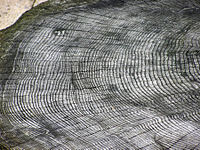
Photo from wikipedia
The main objective of our study was to investigate the possible differences in the chemical composition of extractives from the bark of silver fir (Abies alba) with respect to the… Click to show full abstract
The main objective of our study was to investigate the possible differences in the chemical composition of extractives from the bark of silver fir (Abies alba) with respect to the location of the bark sample on the tree, viz. differences in extract composition between stem bark and branch bark samples. Extractives in the bark samples from branches, depending on the distance of the sample from the trunk, were also analysed, and the stem bark samples were analysed with respect to their inner and outer parts. The results of the chemical analysis of extractives were supported by information about their antifungal and antioxidant effects. After felling and sampling silver fir trees, the collected bark samples were ground and freeze-dried. Extraction of bark samples was followed by a system of accelerated extraction using only water as a solvent. The extracts were analysed chemically using gravimetry, spectrophotometry and chromatography. Free-radical-scavenging activity was measured using the DPPH method, and the antifungal effect towards three moulds and three wood-decaying fungi was investigated with antifungal assay using the agar well diffusion method. It was found that the moisture content in bark samples decreased intensively just after the bark samples were peeled off the stem. Detailed chromatographic analysis showed that the bark extracts contained 14 compounds, among which phenolic acids, flavonoids and lignans were found to be the characteristic ones. The content of hydrophilic extractives in the branch bark samples decreased with increasing distance of the sample location from the tree stem. The largest amounts of phenolic extractives were measured in stem bark, followed by branch bark sampled at the point at which the branch entered the tree. Analysis of the separated parts of the bark showed that the outer layers of stem bark contained larger amounts of phenolic extractives, as well catechin and epicatechin, compared to the inner layers. Concentrated extracts of branch bark showed the largest free-radical-scavenging activity among the investigated samples, while strong antifungal effects of the bark extract were not found.
Journal Title: Molecules
Year Published: 2022
Link to full text (if available)
Share on Social Media: Sign Up to like & get
recommendations!